A lovely, moist honey oat bread, with rolled oats, honey and a bit of whole wheat flour, as well. This bread stays fresh for days and makes a great sandwich bread!
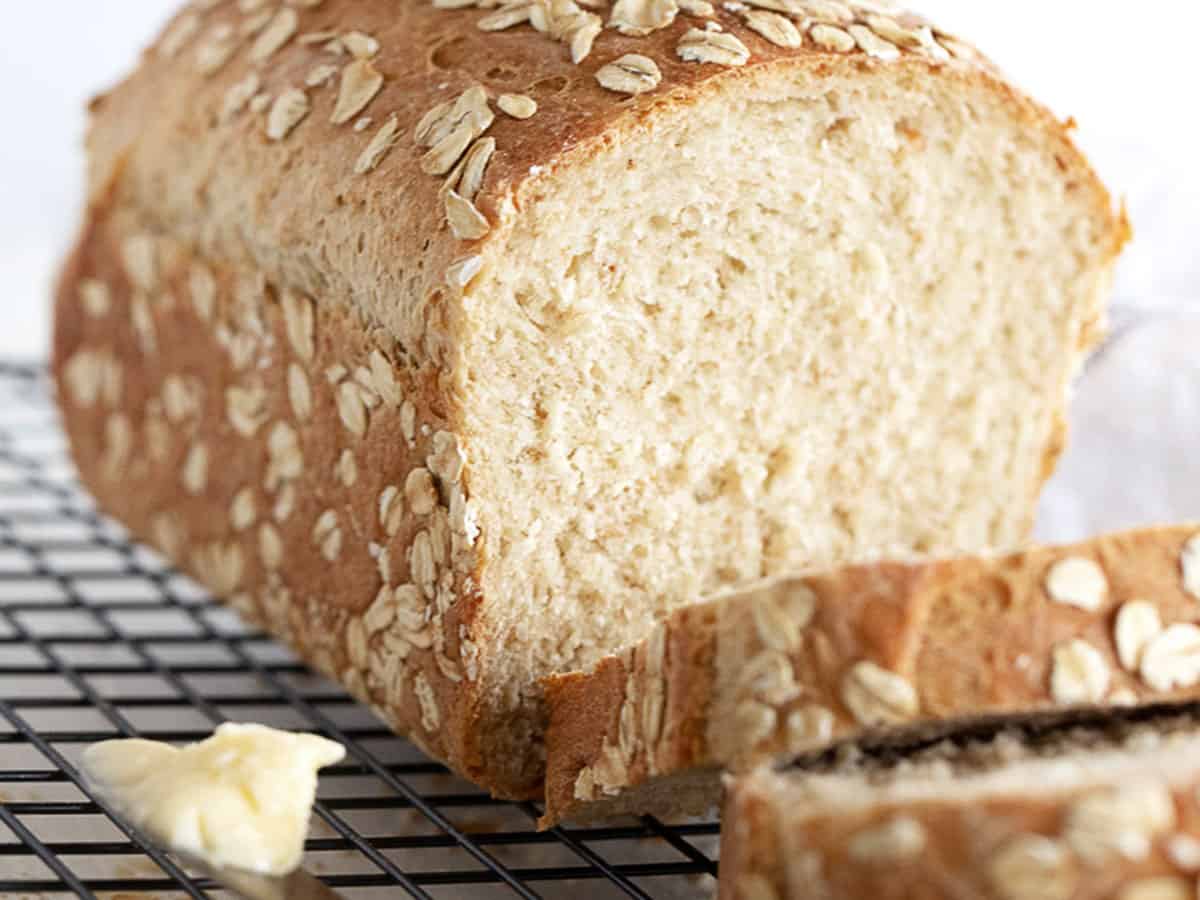
When it comes to bread, I love a loaf that delivers some whole grain goodness, but that also maintains a lovely soft crumb, like my Seeded Multigrain Sandwich Bread. This Honey Oat Bread also falls into that camp, with a good bit of rolled oats and a touch of whole wheat flour added into the mix.
I love this loaf for its great flavour from the oats and honey, its tender, moist crumb and its rustic, oat-rolled appearance. This oat bread keeps well, slices beautifully and makes the most fabulous sandwiches!
Ingredients and substitutions
- Rolled oats – the large-flake, old-fashioned rolled oats are best, though quick oats will work here as well.
- Whole wheat flour – regular whole wheat or white whole wheat are both fine
- All-purpose flour – unbleached all-purpose flour is recommended, but regular bleached is fine
- Honey – or alternately you can use an equal amount of maple syrup or brown sugar
- You will also need – Boiling water, salt and butter (or oil)
Step-by-step photos
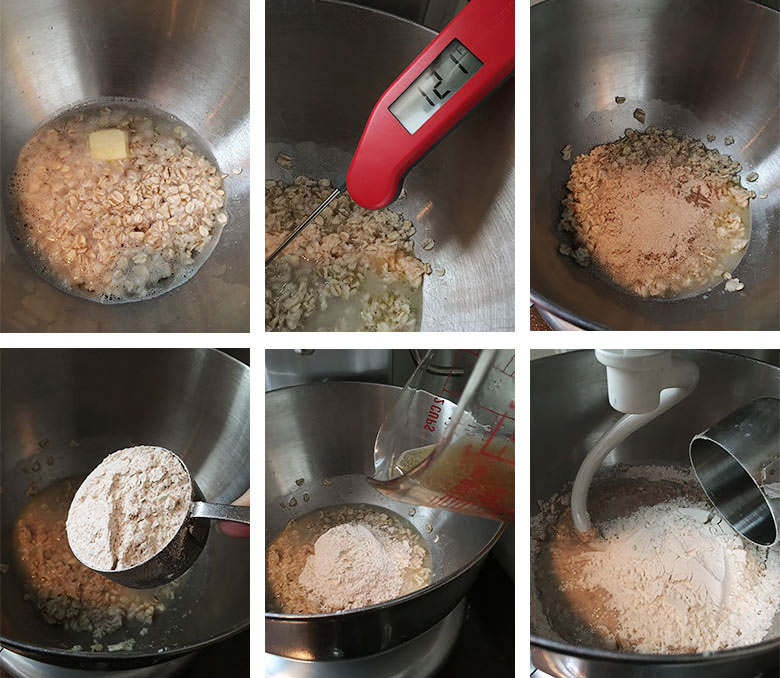
- Step 1: Soak the oats in boiling water with the butter and salt, for 20-25 minutes.
- Step 2: Check the temperature of the mixture. Make sure it’s cooled to lukewarm, about 110F. If it’s too hot when you add your yeast, it will kill the yeast.
- Step 3: Add the proofed yeast mixture.
- Step 4: Add the whole wheat flour.
- Step 5: Add the honey.
- Step 6: Add the first cup of all-purpose flour
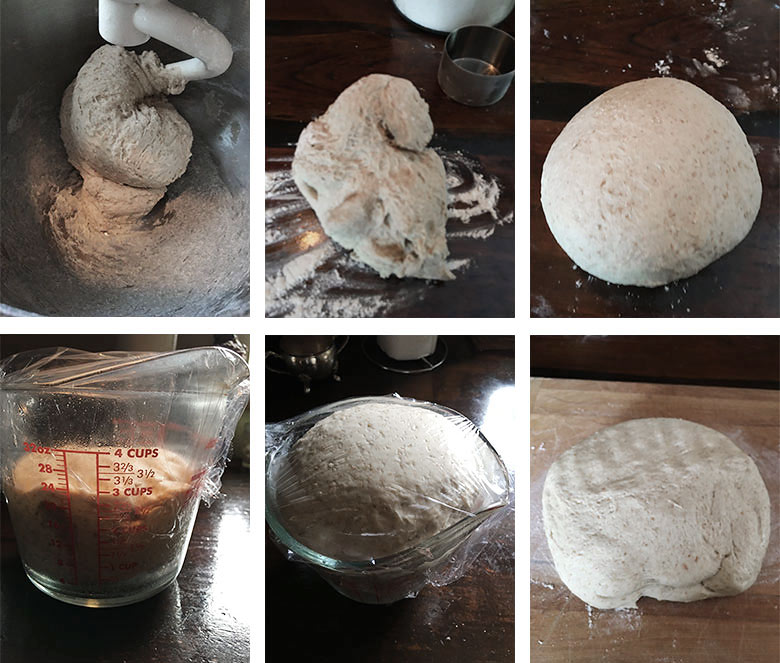
- Step 7: Add another 1 – 1 1/2 cups all-purpose flour until you have a moist dough that wraps around the hook and cleans the bowl a little.
- Step 8: Remove the dough to a floured surface and knead, adding just as much flour as needed to prevent the dough from sticking.
- Step 9: Form dough into a ball.
- Step 10: Place dough into a greased bowl or measuring cup. Cover with plastic wrap.
- Step 11: Let dough rise until doubled.
- Step 12: Remove dough to a floured surface and gently deflate.
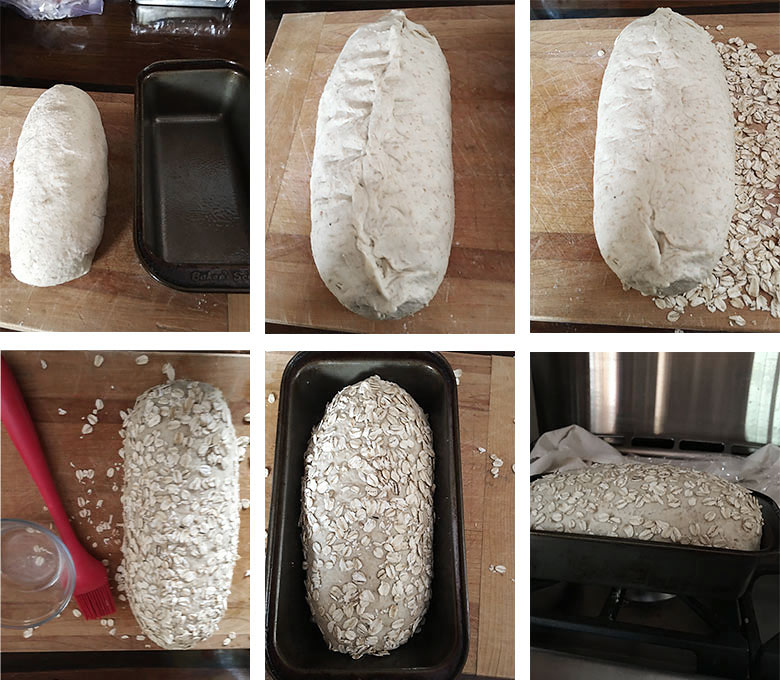
- Step 13: Form dough into a rough oval, about as long as the loaf pan.
- Step 14: Flip the dough over and pinch the sides into the centre, down the length of the loaf, pinching the ends in as well.
- Step 15: Flip back over right side up. Scatter some rolled oats on your work surface.
- Step 16: Lightly brush your loaf with water, then roll over the oats, coating the top, sides and bottom of the loaf.
- Step 17: Place the loaf into a greased 8×4-inch loaf pan. Cover with a greased piece of plastic wrap.
- Step 18: Let the loaf rise until doubled. Remove plastic wrap and bake.
Recipe tips
If you are new to bread making, I highly encourage you to check out my Getting Started With Yeast Bread Baking resource page, to get a good understanding of the process of making homemade bread.
This loaf will need a solid 45 minutes in the oven or until it reaches at least 200F internal temperature when tested with an instant-read thermometer. Be sure you are inserting the thermometer in the dead centre of the loaf for the most accurate reading. It shouldn’t have over-browned in that time, but check your loaf at about 35-40 minutes and if it seems in danger of over-browning, lay a sheet of aluminum foil loosely over top for the last part of baking.
Top tip!
The addition of soaked oatmeal to this bread produces a lovely, moist loaf, but it also means the loaf will need longer in the oven to bake off some of that moisture. This loaf will need at least 45 minutes in the oven, which is quite a bit longer than most bread loaves. A thermometer is best for testing done-ness, but if you don’t have a thermometer, err on the side of leaving it in the oven a few minutes longer, rather than rushing it out, to ensure you don’t end up with a loaf with an under-done middle.
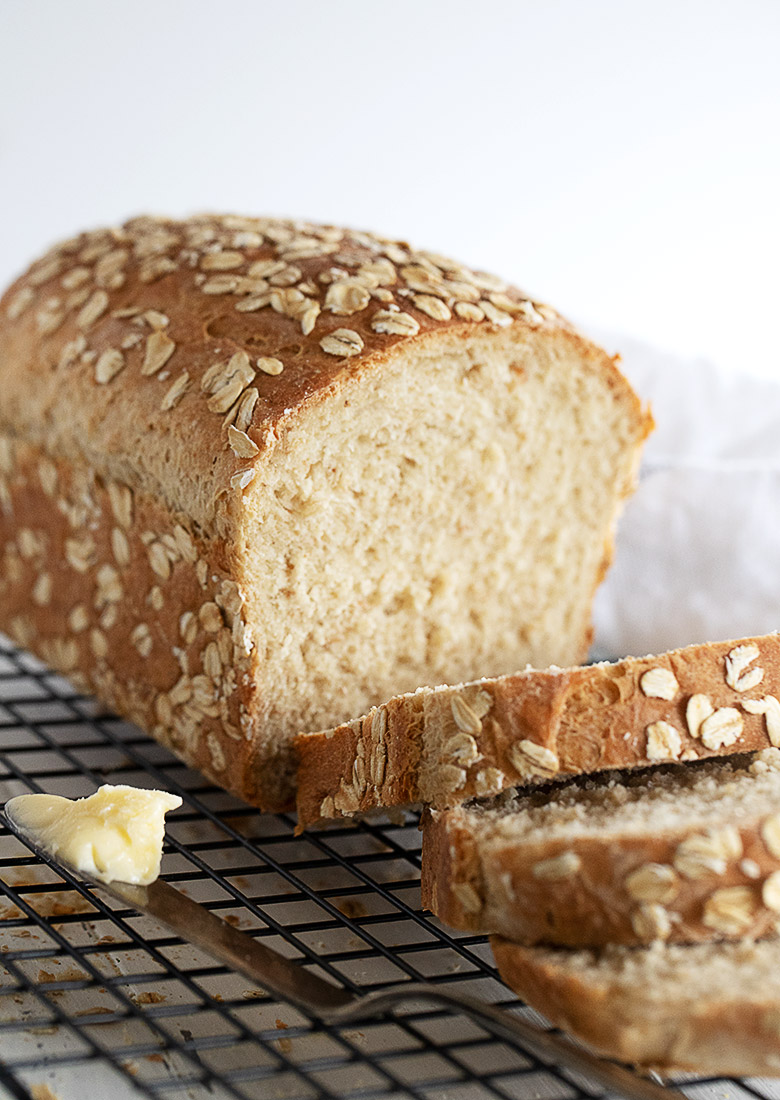
Storing and freezing
This bread will keep well, well-wrapped on the counter for several days. This bread will also freeze beautifully for up to 3 months.
Want to Save This Recipe?
Enter your email & I’ll send it to your inbox. Plus, get great new recipes from me every week!
By submitting this form, you consent to receive emails from Seasons and Suppers.
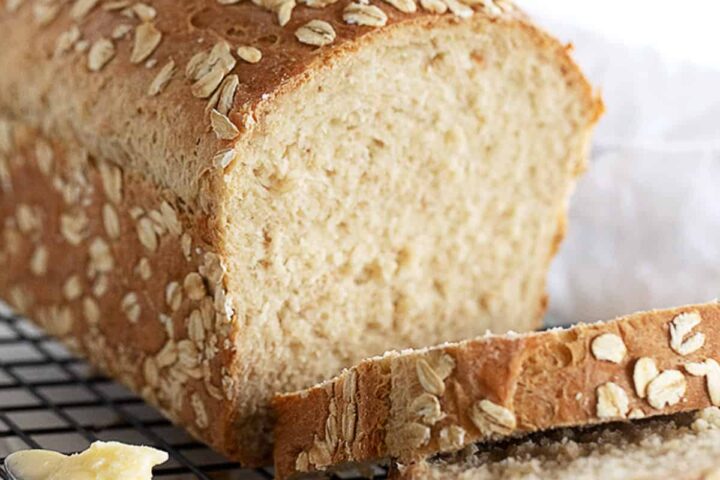
Get the Recipe: Honey Oat Bread
Ingredients
- 1 1/4 cups (285 ml) boiling water
- 3/4 cup large-flake, old-fashioned rolled oats, plus more for coating
- 1/2 teaspoon fine salt
- 2 Tablespoons (28 g) butter, or vegetable oil
- 1/3 cup (75 ml) honey, any mild-flavoured runny honey or substitute an equal amount of maple syrup or brown sugar
- 1/4 cup (55 ml) lukewarm water, about 105F.
- 2 1/4 teaspoons active dry or instant yeast
- 1/2 cup (60 g) whole wheat flour, (or more all purpose flour)
- 2 1/2 – 3 cups (300-360 g) all purpose flour, approximately
Instructions
- Boil some water and measure out 1 1/4 cups. Add to a large bowl or the bowl of a stand mixer. Add the rolled oats, salt and butter and stir to combine. Let stand 20 minutes, to soak and cool. *Be sure your mixture has cooled enough before you add your yeast to the bowl. If it's too hot, you will kill your yeast. Use a thermometer to test the temperature. It should be around 105F to 110F before you add the yeast. If you don't have a thermometer, let cool 5 minutes more and make sure it's just lukewarm.
- Add the yeast to the lukewarm water. Stir and let stand 5 minutes.
- Once the oat mixture is cooled enough, add the honey, proofed yeast mixture, whole wheat flour and the 1st cup of all purpose flour to the bowl. Mix to combine with the kneading hook. With the mixer running, begin adding the 2nd cup of flour in small increments, letting it mix in before adding more. Continue adding this cup and additional flour, if needed, until you have a quite moist dough, but one that wraps around the hook and cleans the bowl in spots. It may still have a sticky bit at the bottom of the bowl. That is ok. Remove the dough to a floured surface and knead a few minutes, adding a bit more flour, only as needed, to prevent it from sticking to your hands or the work surface. Form into a ball. Place into a greased bowl. Cover with plastic wrap and let rise until doubled, about 1 hour.
- Grease an 8×4-inch loaf pan and set aside.
- Remove dough to a lightly floured surface and gently deflate it by pressing down on it with your palms. Form the dough into a rough oval, about as long as your loaf pan (set your loaf pan next to your work area to judge the length). Flip the dough over and pinch in from the sides to the centre of the dough, pinching a seam down the middle. Pinch in the ends, as well. Flip it back over, right side up. Scatter some rolled oats on your work surface. Lightly brush your dough with water (not too much – just a light coating), then roll it over the oats, rolling to cover top, sides and bottom. Place dough into your prepared loaf pan. Spray a piece of plastic wrap with cooking spray and cover the top of the pan tightly. Allow to rise until doubled again, about 45-60 minutes.
- Preheat oven to 350F. (regular bake setting/not fan assisted)
- When dough is ready, remove plastic wrap and bake in preheated oven for about 45 minutes, or until the loaf tests at least 200F with an instant read thermometer. If you don't have a thermometer, insert a tester in the side and into the centre. It should come out clean and dry. If in doubt, leave it in the oven a few extra minutes, as you probably won't hurt it. *It is unlikely that your loaf will over-brown, but check it after about 35 minutes and if it looks like it may over-brown, lay a sheet of aluminum foil loosely over-top for the last part of baking.
- Remove loaf from oven and immediately remove from pan to a cooling rack to cool completely before slicing.
Notes
More oat bread recipes to love!
Hi! I’m Jennifer, a home cook schooled by trial and error and almost 40 years of getting dinner on the table! I love to share my favourite recipes, both old and new, together with lots of tips and tricks to hopefully help make your home cooking enjoyable, stress free, rewarding and of course, delicious!


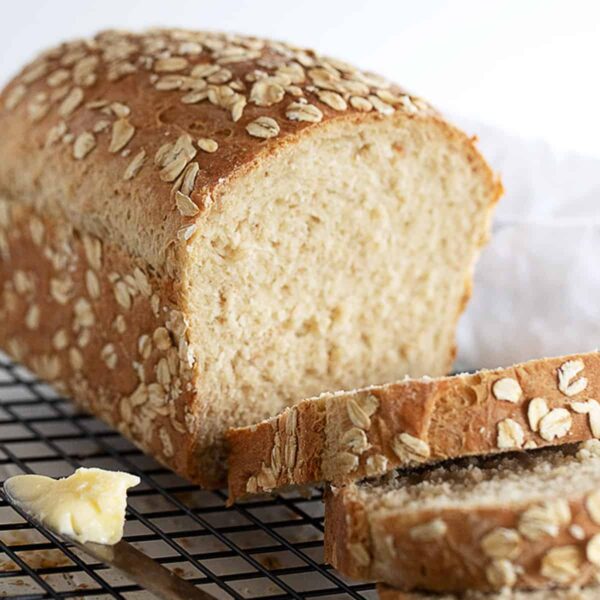
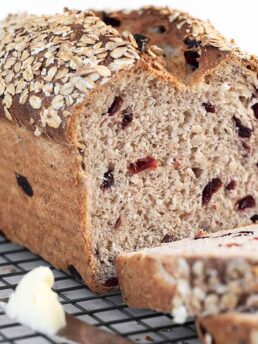
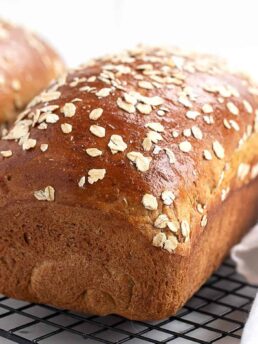

This was absolutely delicious! I substituted the wwf with spelt (as I had none). As well, I accidentally over-proofed it! I hadn’t realized how well this dough rises. On the second rise I won’t proof it as long :) I did find it baked longer (just over 60 minutes) but that could be because of the spelt and material of my bread pan. Thank you so much for the sharing.
So glad you enjoyed it, Nannette :) Thanks so much!
Thanks Jennifer, made this with double the quantity. This was my first Oatmeal bread that rose so well, but keeping it for 45 minutes in the oven was a bit too much. The bottom and the top were overdone, next time will keep it for lesser time. But the Insides of the bread baked perfectly. I followed your recipe to the tee with one additional add on i.e. the juice of one lemon. I feel it helps keep my bread from spoiling for a longer period outside, as I live in a humid area.
So glad you enjoyed it, MaryAnn! Thanks so much :)
Do you think you could make this bread without a loaf pan, like a free form loaf
Hi Nancy, I’m not sure this is the best candidate for a free-form loaf, as it is a very moist dough. I fear it might just spread out as it rises and bakes, into a rather flat loaf. If you’re ok with that, you could give it a try. Another option might be to use something that constrains the spread a bit, such as a cast-iron skillet or even a round cake pan. Just a thought. If you try it, let me know how it worked out :)
Is the nutritional information based on one or two slices? My granddaughter is diabetic and I need the precise carb amount!
Hi Sabrina, the nutritional information should not be relied on to make health decisions, as a “slice” is an imprecise measure. I suggest making your own calculations based on how many slices you take from your loaf.
Hi Jennifer,
I can’t wait to try that bread recipe. Can I use whole wheat flour only?
Thanks
Hi Raymonde and no, you can’t use all whole wheat in this recipe, as it will not only create a dense loaf, but it will need a different liquid amount as it absorbs liquid differently. You could replace about 1/4 of the all purpose flour with whole wheat flour without too much issue. You may need to use a bit less flour over-all with the added whole wheat.
Hi Jennifer,
This is my second favorite after your maple sandwich bread! It was very moist and makes a lovely taste on toast. Thank you!
Thanks so much, Annie. So glad you are enjoying it. It’s one of my favourites, too :)
Hi Jennifer! Seeking help. The bread is awesome – moist and wonderful to taste .BUT the bottom of the loaf is bit more ‘dense’ vs the top part which is more like the store brought bread. What did I do wrong ?
Hi Sonali, It’s often hard to diagnose, but my gut says maybe it is over-proofed, causing the bottom to collapse under the weight of the top. Is that possible? How long are you leaving it for the second rise?
Hi Jennifer, Do you think I could do the first rise in the fridge overnight?
Hi Jan, I seldom do overnight rises (unless the recipe specifically calls for it), so I don’t have a lot of experience on that front. Generally speaking, it’s ok. I worry a bit about this one as it’s a super-fast riser, so I worry that even in the fridge, it might over-rise. That’s the only caution I’d have.
We do not need to put sugar with the yeast water mixture?
Not really. It’s not necessary at all if using Instant Yeast. If using Active Dry Yeast, you can add a tsp of sugar if you like, but modern Active Dry yeast does not “need” it.
Thank you for sharing such a moist and beautifully textured bread for making sandwiches. The one thing which I did differently was to use a moist towel instead of plastic wrap when waiting for my dough to rise. It worked well and the reason for this swap is to be more earth friendly.
So glad you enjoyed it, Bela. Thanks so much!
Can I use instant rapid yeast?
Hi Madeleine, Generally speaking, rapid-rise yeast is intended for single-rise bread. As this is a double rise bread it may not work. It may, I just can’t say for sure, as it is not a yeast that I use.
I made this bread today. Perfect! Thank you for the recipe
So glad you enjoyed it, Molly :) Thanks so much!
This does look like perfect sandwich bread. I’m dreaming of an egg salad sandwich on it!
Thank Chris and yes, egg salad is always a good idea :)
I’ve finally started baking bread, so I’ll need to add this one to the list. The addition of oats sounds extra wholesome, and from your photos, the bread looks soft and fluffy! Stay well Jennifer.
Thanks Leanne and yes, this is lovely and soft bread, for sure :)
Perfect for sandwiches or alongside that bean soup Jennifer! You always inspire me when it comes to bread baking!
Thanks Mary Ann and yes, perfect with the soup :)
Lovely loaf Jennifer! I tried an oatmeal bread recipe recently but was’t thrilled. I’m going to make yours next :) It looks perfect. Thanks so much for sharing.
Thanks so much, Tricia :) This is one of my favourite loaves for eating out of hand or sandwiches. It does make nice toast, as well, but as it’s a very moist loaf, it doesn’t get super crispy in the toaster.